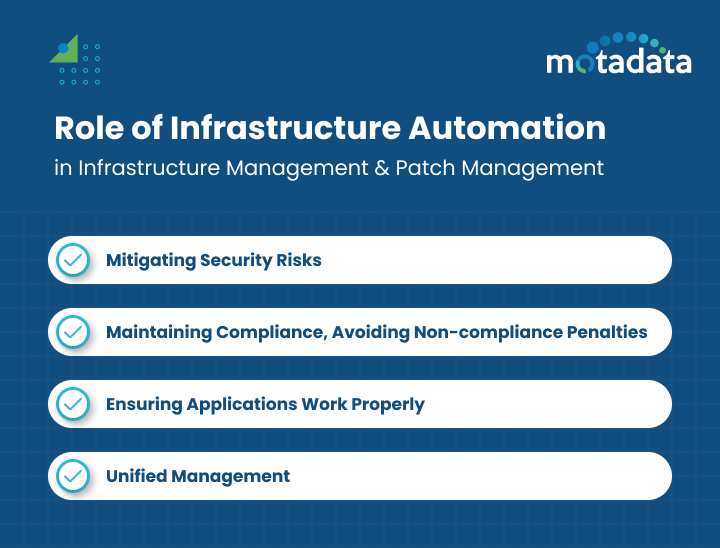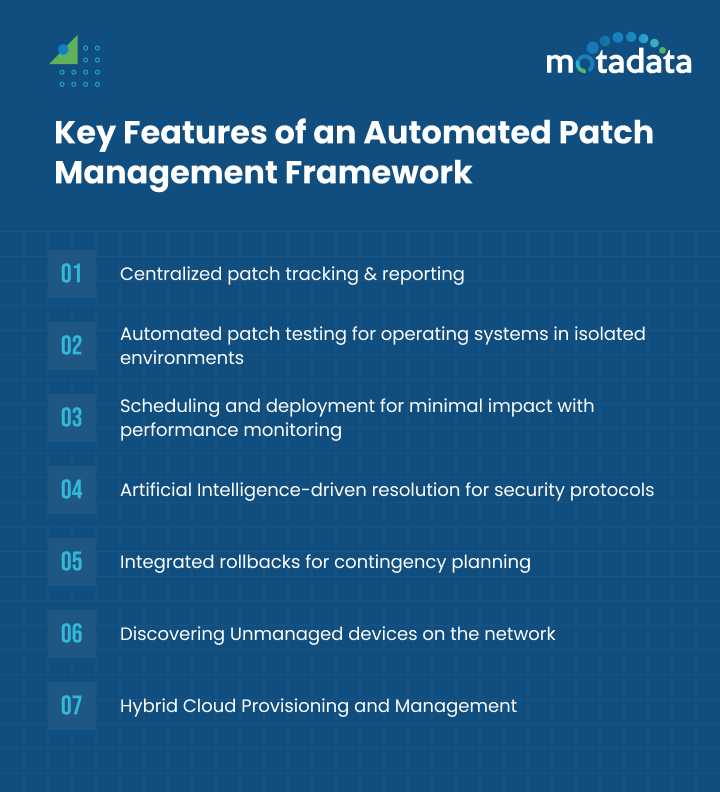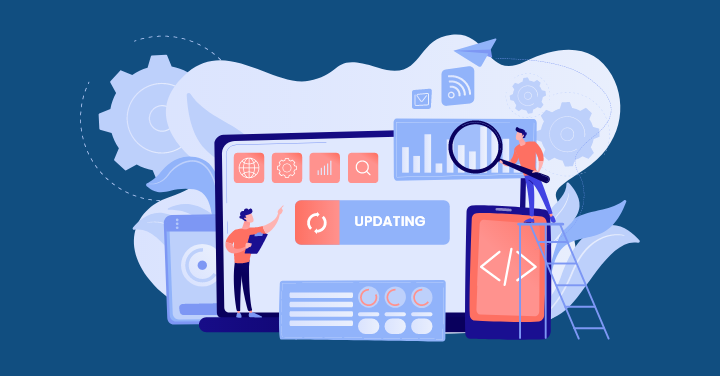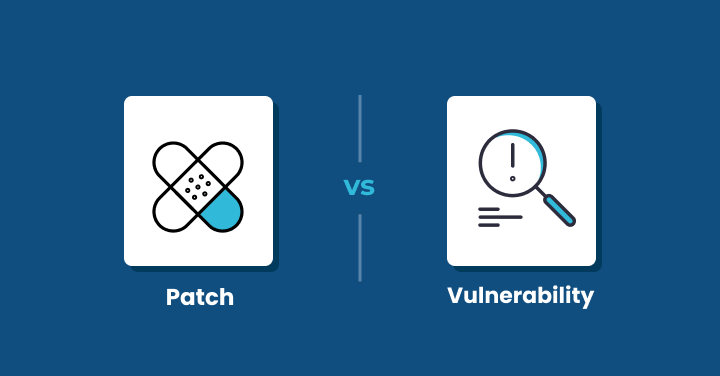Modern enterprises face many challenges, hampering efficiency and innovation amidst tight budgets and safeguarding your brand against escalating cyber threats. Unpatched systems are also prime targets for cybercriminals who aim to access an organization’s sensitive information, intellectual property, and confidential business data.
Traditionally, addressing these challenges required many point solutions, creating disjointed management. Comprehensive, proactive patch management with infrastructure automation tools and proactive monitoring is designed to address these business challenges head-on.
An infrastructure IT management platform provides organizations with the tools to gain visibility, manage, control, secure, and ensure compliance across their entire IT infrastructure with a unified approach to endpoint management.
It streamlines the patch management process to across devices running different operating systems and different applications. With patch management automation solutions, patches are deployed quickly for thousands of devices across the company.
In this blog, we will discuss the need to streamline proactive patch management with infrastructure automation for better security, minimized downtime, and seamless IT operations. Keep reading to stay ahead of cyberattacks!
Understanding Proactive Patch Management
Cybercrimes are on the rise; securing computing devices across the enterprise network is imperative for every business. Patch management manages all the computers across the enterprise network to keep them up to date.
These patches are made available for off-the-shelf applications, middleware, operating systems, and in-house developed applications, leaving no room for cybercriminals. Every software is periodically updated and patched to add new features and fix vulnerabilities.
Installing an automated patch management solution further helps you reduce the time and effort required to patch systems, especially when organizations have multiple tools, multiple operating platforms, and different patch teams.
Role of Infrastructure Automation in Infrastructure Management and Patch Management
Organizations choosing infrastructure automation in patch management minimize problems resulting from manual processes while improving IT staff productivity.
The process starts with automation of the entire patch management process, right from scanning all the devices in the network to detect the missing patches, testing the patches on a test group of systems, deploying them to the required systems, and finally providing periodic updates and reports on the patch deployment status. Additionally, managing and securing data storage is crucial during the patch management process to ensure data integrity and performance.
Automation in patch management enables staff to focus more on other potentially more important activities and boosts their productivity. An effective patch management solution and process benefits organizations with the following:
Mitigating Security Risks
Automated patch management allows the rapidly installed security updates at scale and reduces the security risk across the entire IT ecosystem. Automation mitigates the risk from zero-day vulnerabilities and other known exploited vulnerabilities, reducing downtime of servers and end-user computing devices.
Maintaining Compliance, Avoiding Non-compliance Penalties
Businesses in different industries or geographies must adhere to regulations like the GDPR, PCI, etc.; only effective patching and vulnerability remediation can help you comply. Maintaining patching with automation allows organizations to stay up to date with the latest laws, rules, and standards that apply to their industry.
Ensuring Applications Work Properly
Applying patches in a timely fashion ensures smooth application operation. It reduces business downtime without creating an unnecessary burden on service desk personnel. Automatic infrastructure to do so further relieves your employees, applying patches and software updates whenever they are available.
Unified management
Infrastructure automation offers a unified approach to endpoint management, providing a single platform to manage all devices- remote, on-premises, or in the cloud.
An automated solution can remove the manual steps to enhance IT team productivity, unify management approach, simplify IT operations, and improve overall visibility and control. The whole application framework performs automatic, systematic checks and then downloads the patches.
Key Features of an Automated Patch Management Framework
An intelligent hybrid infrastructure automation offering leverages cybersecurity, automation, and analytics capabilities to proactively identify and remediate vulnerabilities in real-time. Such enterprise infrastructure management offers extensive out-of-the-box (OOB) support alongside robust analytics and reporting capabilities.
Businesses leverage rich capabilities for system provisioning, complex multi-endpoint and multi-platform patching, software asset management, remote control, and work lifecycle management. If integrated with comprehensive hybrid cloud lifecycle management, it also enables automated provisioning, decommissioning, and management of Cloud and On-Prem resources.
Enterprise infrastructure automation may also include intelligent runbook automation that enables rapid attainment of zero-touch automation by employing Machine Learning (ML) and Natural Language Processing (NLP) to comprehend issues, recommend corrective actions, and initiate automatic resolutions.
Utilizing a substantial repository of configurable and reusable automation and runbooks, Enterprise+ ensures robust end-to-end incident remediation and task automation across the entire infrastructure and applications landscape.
This comprehensive offering reinforces IT infrastructure management’s commitment to providing advanced solutions that integrate seamlessly into enterprise environments, fostering efficiency, responsiveness, and automation sophistication.
Here is a brief of the highlights of the automated infrastructure management:
Centralized patch tracking and reporting
A single console or dashboard can manage and deploy patches for all devices, applications, or platforms, usually with automation and central servers that distribute patches across the organization’s IT infrastructure.
It monitors patch status and generates reports on patch compliance and performance. You can integrate with other tools or systems, such as vulnerability scanners, inventory managers, or configuration managers.
Automated patch testing for operating systems in isolated environments
It introduces monitoring and alerting features that provide the patching process is efficient and constantly under observation. These systems integrate well with other vulnerability scanning tools and security databases to continuously monitor systems for known vulnerabilities.
Scheduling and deployment for minimal impact with performance monitoring
Scheduling regular patch deployments and monitoring their progress are essential components of an effective patch management program. The schedule identifies when the vendor releases or makes available software updates. Releases are usually publicized in advance.
This helps system administrators and users decide which patches to apply. By staying on top of patch deployment, you can maintain visibility into your organization’s efforts and make data-driven decisions to improve security.
Artificial Intelligence-driven resolution for security protocols
The all-in-one infrastructure management framework utilizes AI for quick problem-solving. An intelligent IT automation framework leverages machine learning (ML) and natural language processing (NLP) to automate the enterprise technology operation lifecycle, identifying areas for improvement and providing extensive support for rapid issue resolution.
Integrated rollbacks for contingency planning
Automated systems can quickly trigger a roll-back if a patch causes problems during deployment, reverting the system to its pre-patch state.
Discovering Unmanaged devices on the network
Infrastructure automation with patch management checks and discovering unmanaged, rogue devices that can present a serious security threat to the organization’s network.
It will help organizations to automatically see IP-addressable devices that are not under management, allowing security to check and quickly bring these devices under automated patch management. Its collaborative approach protects your brand and empowers informed decision-making.
Hybrid Cloud Provisioning and Management
The enterprise management framework simplifies the lifecycle management of hybrid cloud environments with automated provisioning, policy-driven orchestration, and seamless integration of IaaS, PaaS, and multi-machine blueprints, enabling faster and more efficient resource deployment.
It aligns C-Suite, IT, and security with the only vulnerability remediation solution that combines threat intelligence and instant exposure analysis into one package, delivering quantifiable risk reduction.
Conclusion
With all software vendors’ constant barrage of patches, managing a diverse IT environment with multiple tools can be challenging and inefficient. It’s no wonder that IT organizations struggle to keep their systems updated.
Automation keeps up with all available patches, protecting remotely located components. Customers use enterprise infrastructure management to keep over one hundred million endpoints continuously patched to deliver a first-pass patch success rate. It decreases your patch cycle time and effort, improves the productivity of IT staff, and decreases security risk.
IT infrastructure management with proactive patch management provides visibility of every endpoint in almost all the enterprise networks – OS, location, or connection. It provides a comprehensive endpoint management solution for every operating system, like Windows, Windows IoT, UNIX, Linux, macOS, iOS, Raspberry Pi, and Android.
The enterprise infrastructure automation offers a comprehensive, integrated solution. It handles patch management, software deployment, OS deployment and upgrades, mobile and modern device management, compliance management, vulnerability remediation, and patching systems that are on-premises, in the cloud, at home, or remote.








